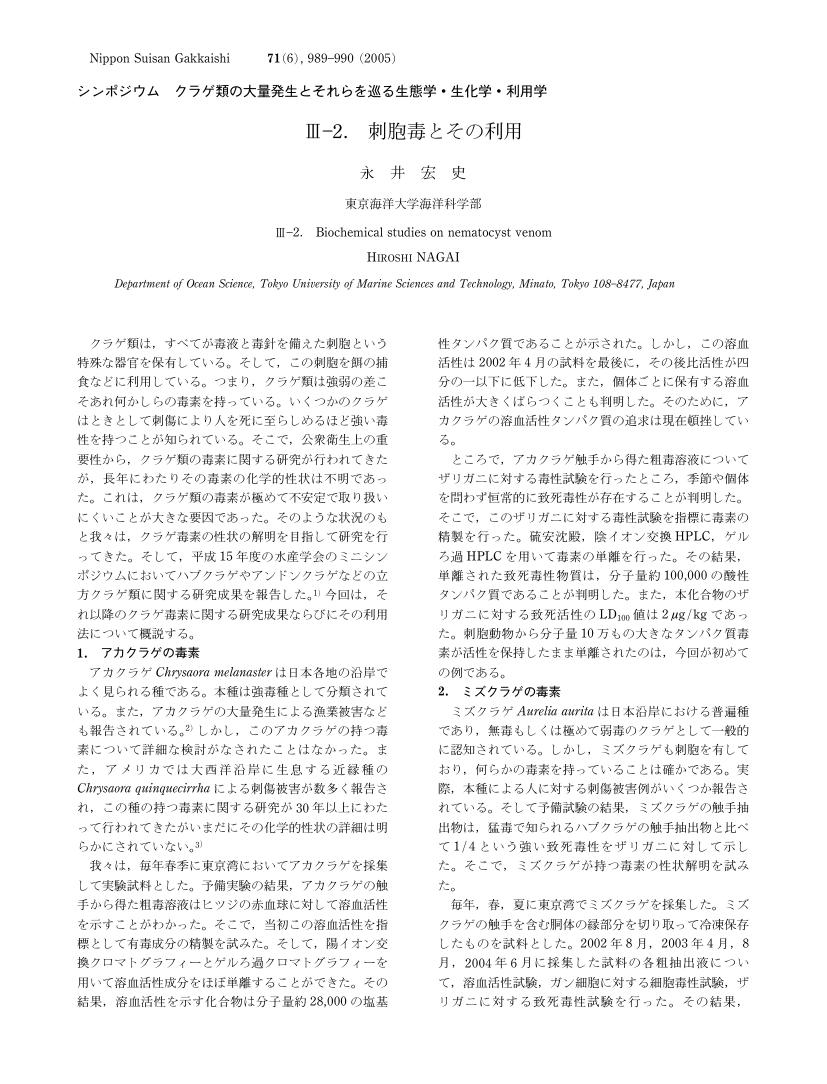3 0 0 0 OA III-2. 刺胞毒とその利用
- 著者
- 永井 宏史
- 出版者
- 公益社団法人 日本水産学会
- 雑誌
- 日本水産学会誌 (ISSN:00215392)
- 巻号頁・発行日
- vol.71, no.6, pp.989-990, 2005 (Released:2005-12-05)
- 参考文献数
- 5
- 被引用文献数
- 3 3
1 0 0 0 OA P-28 刺胞動物に特異的に存在する環状ペプチド cnidarin 類
- 著者
- 永井 宏史 五十嵐 文子 北谷 龍樹 内田 肇 渡邊 龍一 鈴木 敏之 Masoud Shadi Sedghi 長澤 和夫
- 出版者
- 天然有機化合物討論会実行委員会
- 雑誌
- 天然有機化合物討論会講演要旨集 第59回天然有機化合物討論会実行委員会 (ISSN:24331856)
- 巻号頁・発行日
- pp.585-590, 2017 (Released:2020-09-20)
Jellyfish, sea anemone and coral are classified as members of the phylum Cnidaria. All cnidarians have a stinging cell, cnidocyte, and its stinging organelle nematocysts. Nematocyst stores venom and coiled needle inside and discharge the needle and inject venom into their prey. Both physical and chemical stimuli trigger nematocyst discharge. A lot of studies on the venom of cnidarians have been accomplished. As the results, it has been revealed that most of cnidarian venoms consisted of proteinaceous toxins. However, there are few studies on the low molecular weight compounds from the cnidarian nematocysts. Therefore, we started the search of low molecular weight compounds in the nematocyst. First target was the venomous jellyfish Chironex yamaguchii (Habu-kurage in Japanese). Nematocysts were isolated from C. yamaguchii tentacles. The isolated nematocyst and C. yamaguchii tentacle without nematocyst were extracted with 1 M NaCl solution using a mini-bead beater machine. The extracts were screened with LC-MS. It was clearly shown that three compounds all of which have [M+H]+ 517 were existed especially in nematocysts. Three compounds were isolated with HPLCs. NMR and MS spectra data of isolated compounds revealed their planar structure as cyclic γ-tetra glutamic acids. The determination of absolute stereochemistry of these compounds was established with organic synthesis, comparing optical rotation values and Marfey’s analysis. Three cyclic γ-tetra glutamic acids were designated as cnidarin4A (1a), cnidarin4B (1b) and cnidarin4C (1c), respectively. Cnidarin4A and cnidarin4B were new compounds. Cnidarin4C was first obtained as the natural product in this study. The existence of these compounds in marine animals has been studied using LC-MS. Cnidarin4s were detected from all the nine tested cnidarians, on the contrary no cnidarin4s were detected from all the seven tested the other phylum animals. Cnidarin4s are especially existed in animals of the phylum Cnidaria. The ecological role of cnidarin4s in cnidarians is a challenging subject to be elucidated.
1 0 0 0 OA カミクラゲの有するキュウリ様匂い物質の同定
- 著者
- 吉田 優花 五十嵐 史子 高橋 希元 大迫 一史 永井 宏史
- 出版者
- 公益社団法人 日本水産学会
- 雑誌
- 日本水産学会誌 (ISSN:00215392)
- 巻号頁・発行日
- pp.18-00039, (Released:2018-12-04)
- 参考文献数
- 16
- 被引用文献数
- 1
新鮮なカミクラゲSpirocodon saltatrixは,独特な強い匂いを有することを見出した。その匂いはキュウリ様臭であった。そこで,このカミクラゲの有する特徴的なキュウリ様匂い物質について同定を試みた。GC/MS, GCを用いた官能試験,標品を用いた試験結果から,カミクラゲの有するキュウリ様臭物質は(E)-2-nonenalならびに(E,Z)-2,6-nonadienalと同定した。
1 0 0 0 クラゲ刺胞由来タンパク毒の化学的性状および作用機序の解明
刺胞動物門に属するクラゲはすべてが刺胞毒を有し、そのうち強力な刺胞毒を有するいくつかのクラゲは世界中で海水浴客や漁民に刺傷被害を与え、死亡例も報告されている。クラゲの毒素の化学的性状の解明についてはほとんど手つかずの状況であった。これは、それまで研究されたすべてのクラゲ毒素が非常に不安定であることに主に起因していた。このような状況のもと、我々は非常に不安定なクラゲタンパク質毒素を比較的安定に取り扱う方法を見出し、クラゲ数種からタンパク質毒素を活性を保持したまま単離することに成功した。さらに分子生物学的手法を用いてアンドンクラゲ(Carybdea rastoni)、ハブクラゲ(Chiropsalmus quadrigatus)、Carybdea alataの計三種の立方クラゲのタンパク質毒素の全アミノ酸一次配列の解析に成功した。これはクラゲ毒素類の化学的性状が明らかにされた初めての例である。これら立方クラゲ類の毒素同士は相同性があるが、既知のタンパク質とは全く相同性を有していなかった。つまり、我々の研究により新奇な生理活性タンパク質ファミリーの一群を見出すことができた。
1 0 0 0 ヒトデ類の自切を誘導する生体成分の構造と機能に関する研究
日本に棲息するヒトデ類の中には、捕食者に襲われたり物理的に傷付いた時に、障害を受けた腕を切り離す能力をもつものがいる。マヒトデ(Asterias amurensis、キヒトデとも言う)はその代表的な例である。本研究では東京湾と陸奥湾のマヒトデを対象に、自切誘導の刺激が加えられてから腕が切り離されるまでの経過の観察、自切中のヒトデの切片標本の作成と光学顕微鏡観察、および自切を誘起する生体成分(自切誘導因子、APF)の分離を行った。東京湾のマヒトデは陸奥湾のものよりも自切しやすい。マヒトデをオートクレープバックに入れ、加熱して自切させて得られる体腔液を正常なマヒトデの腕に注射すると自切が誘導されるので、これを生物検定法に用いて研究を行った。マヒトデの腕にAPFを含む溶液を注射し、口側と反口側の両方からビデオ撮影して外部変化を観察した。また、開裂部の組織切片の顕微鏡観察を行った。外部観察より、自切の始めに反口側の体表のコラーゲン組織の軟化が起こり、次に口側の歩帯板が断裂することが分かった。この時、ヒトデは自切させる足を固定し、表皮のコラーゲン組織を引きちぎる行動を示した。組織切片の観察では、歩帯板をつなぐ筋肉の異常な収縮が観察された。このことから、歩帯板の断裂は、歩帯板間をつなぐ筋組織の逆向収縮により、コラーゲン組織からなるじん帯が引き割かれることによって起こると考えられる。加熱処理した体腔中に放出されるAPFの分離を行った。自切を観察する生物検定試験を指標にして、ゲルろ過クロマトグラフィー、次いで高速液体クロマトグラフィーを繰返すことによりAPFを分離した。ほぼ単一のピークを示すHPLCフラクションが自切を誘導することを突き止めた。この物質は超微量しか含まれていないため、HPLC分取を繰り返して^1H及び^<13>C NMRスペクトルを測定した。最終構造の決定は現在なお進行中であるが、この物質はニコチンアミドの誘導体と考えられる。
